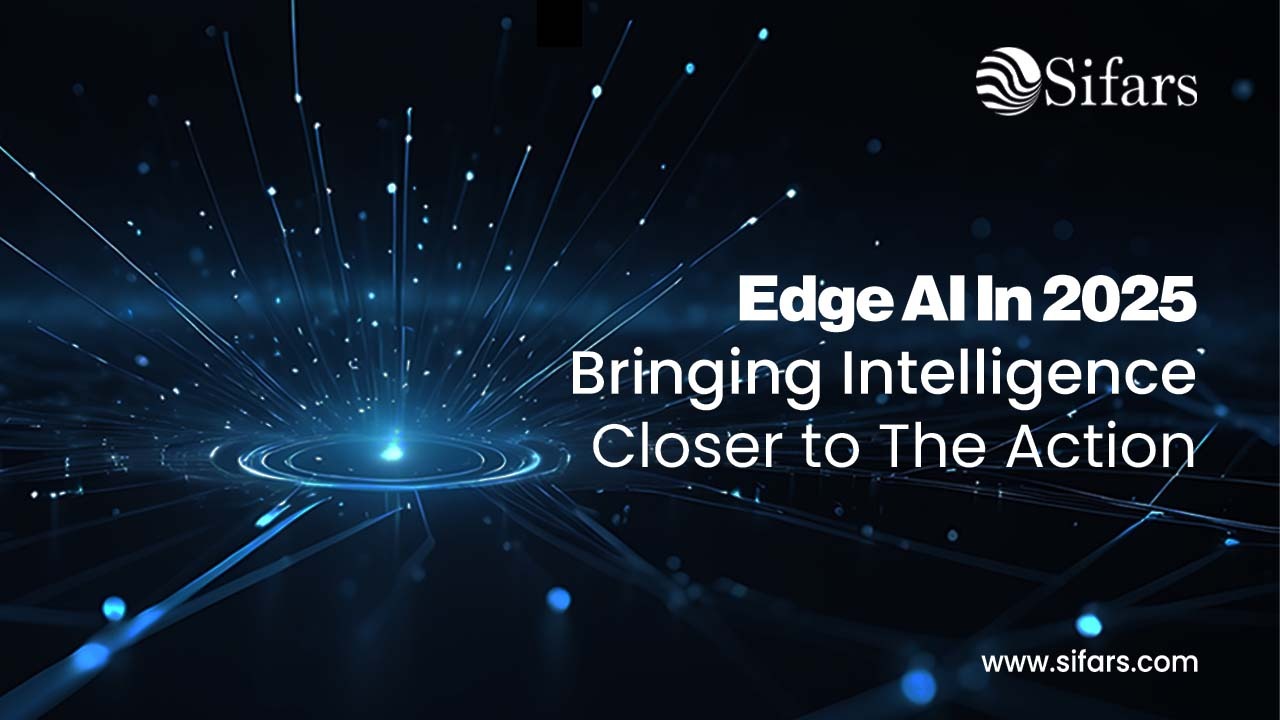Why Edge AI Is the Next Frontier
In a world where split-second decisions can make or break outcomes—from manufacturing anomalies to real-time traffic routing—centralized AI isn’t always fast or reliable enough. That’s why Edge AI in 2025 isn’t just big—it’s essential. By placing intelligence physically close to where data is generated, businesses gain real-time responsiveness, enhanced privacy, and reduced latency. Leading sectors like retail, energy, manufacturing, and healthcare are already deploying edge AI solutions to power autonomous processes and smarter decision-making on the ground.
This reading dives deep into how edge AI is reshaping technology adoption, explores use cases across industries, and explains how Sifars equips organizations to implement Edge AI with confidence—enabling seamless outcomes without dependency on upstream infrastructure.
1. What Makes Edge AI Different—and Why It Matters
- Reduced Latency: Processing happens on the device or gateway—network lag becomes no longer a bottleneck for real-time decisions.
- Lower Bandwidth & Cost: Raw data stays local; only valuable insights go upstream—saving bandwidth and cloud compute spend.
- Improved Privacy & Compliance: Sensitive information processes on-site and stays local, aligning with data protection laws.
- Operational Resilience: Even with intermittent connectivity, edge AI keeps systems autonomous and self-sustaining.
In 2025, edge AI has entered the mainstream—not as a niche experiment, but as a baseline expectation for intelligent systems that operate at the periphery.
2. Real-World Edge AI: Who’s Leading—and How
Manufacturing: Smart Fault Control
At a German auto plant, edge AI cameras analyze equipment vibration patterns in real-time. Faults are detected instantly, minimizing downtime and boosting line output by 25% without wall-to-wall cloud calls.
Retail: Adaptive Digital Signage
Smart in-store displays use edge intelligence to analyze foot traffic and display relevant offers instantly—raising conversion rates by 15%—all without sending raw video data to the cloud.
Agriculture: Autonomous Harvesting
Harvesters use edge AI to detect crop maturity and adjust harvesting speed autonomously—boosting yield by 12% and trimming water usage by 18%.
Healthcare: Patient Monitoring
Smart wearable monitors analyze biomarkers on-device and only send critical alerts—managing patient data privacy and reducing network dependency in clinical environments.
3. Why 2025 Is Edge AI’s Breakthrough Moment
Maturity of Hardware
AI-capable processors like NVIDIA Jetson Thor and cloud-like ASICs now fit industrial environments with growing performance and lower power footprint.
More Data on the Move—Less Time to Respond
IoT expansion created data flood. Central cloud analytics alone can’t scale: 7 in 10 executives see data explosion as a growth limiter without edge filtering.
Hybrid AI Architectures Become Standard
APIs and edge containers let teams run synchronized intelligence across devices and cloud—enabling rapid insights and adaptability without losing scale or governance.
Regulatory Pressures and Data Governance
With data sovereignty laws strengthening, edge AI permits local compliance (e.g. GDPR, HIPAA) without disrupting business intelligence needs.
4. How Companies Can Implement Edge AI—The Sifars Path
1. Identify On-Site Needs with Real Impact
Start with edge-friendly use cases: anomaly detection, real-time personalization, or predictive maintenance.
2. Choose Fit-for-Purpose Infrastructure
Select hardware (gateways, embedded AI modules) designed for your environment—temperature, connectivity, uptime.
3. Develop Lightweight Models
Use quantized neural nets or small transformer variants optimized for edge. Sifars supports model pruning and localization for efficiency.
4. Build Hybrid Pipelines
Distribute logic: inference happens edge-side, while model updates, aggregation, and longitudinal analytics run in the cloud.
5. Govern Trustfully
Ensure edge models are explainable and auditable. Use end-to-end monitoring to detect model drift or bias—both locally and centrally.
6. Monitor Lifecycles
Deploy tools for mass rollouts, OTA updates, and version control—so your edge systems stay resilient and aligned with evolving business needs.
5. Pitfalls to Avoid with Edge AI
- Overloading Low-Resource Devices: Always tailor models to hardware—don’t expect server-grade performance at the edge.
- Ignoring Power Constraints: Choose energy-efficient models—especially for remote or battery-powered deployments.
- Splitting Logic Without Sync: Hybrid design needs alignment. Uncoordinated edge/cloud logic leads to inconsistencies.
- Underestimating Model Drift: Edge models need retraining and monitoring to stay accurate over time.
Ground Your AI at the Edge
Edge AI in 2025 isn’t fringe—it’s foundational. With low latency, smart autonomy, and data-safe operations, businesses can respond faster and scale smarter. By implementing edge AI solutions thoughtfully—per the Sifars framework—you can deliver real-time intelligence where it actually matters.
Let Sifars guide your edge AI transformation—helping you bridge innovation and outcomes without growing complexity. Ready to bring intelligence closer to action? Let’s connect.

Leave a Reply